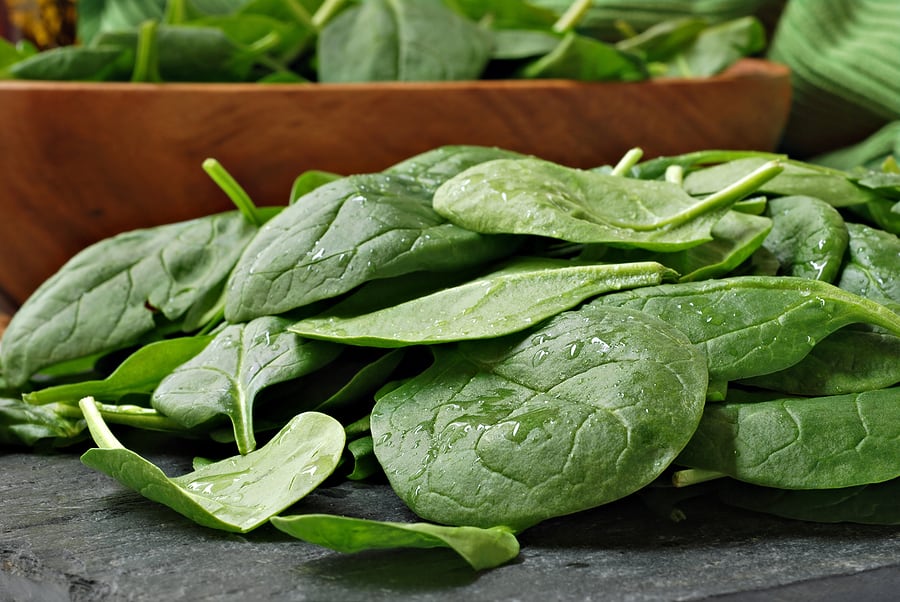Spinach has just the right balance of flavor—sharp and hearty but not overpowering. It is equally versatile raw or cooked.
There are two main types of spinach: flat-leafed and savoy or crinkle-leafed. The more tender and mild tasting of the two is flat-leafed especially the baby varieties. Savoy spinach has a stronger flavor with a slightly bitter aftertaste.

How to choose spinach
- Select spinach with crisp and dark green leaves that have a fresh fragrance.
- Avoid leaves that are limp, damaged, or discolored.
- Small baby spinach will have the most flavor and tender texture; older leaves will tend to be bitterer in flavor and have a chewier texture.
Spinach articles on Harvest to Table:
- How to Plant and Grow Spinach
- Spinach Seed Starting Tips
- How to Harvest and Store Spinach
- Spinach Growing Problems: Troubleshooting
- Six Ways to Cook and Serve Spinach
- How to Grow New Zealand Spinach
- How to Grow Malabar Spinach
How to store spinach
- Spinach can be refrigerated in a plastic bag for up to 3 days.

How to prep spinach
- Spinach leaves should be separated and cleaned in a bowl of cold water to loosen grit and dirt or soaked in a bowl of salty water for 10 minutes to remove bugs and then rinsed under cold running water to remove dirt.
- Wash spinach just before using it so that it does not become soft. Remove the stems once washed unless the spinach is very young.
- Spinach will shrink when cooled.
Kitchen Helpers from Amazon:
- Oster Vegetable Steamer
- Chef’s Knives Set of 6
- EZ Off Jar Opener for Weak Hands
- Pepper Core Remover Stainless Steel
- Kitchen Utensils – Set of 35
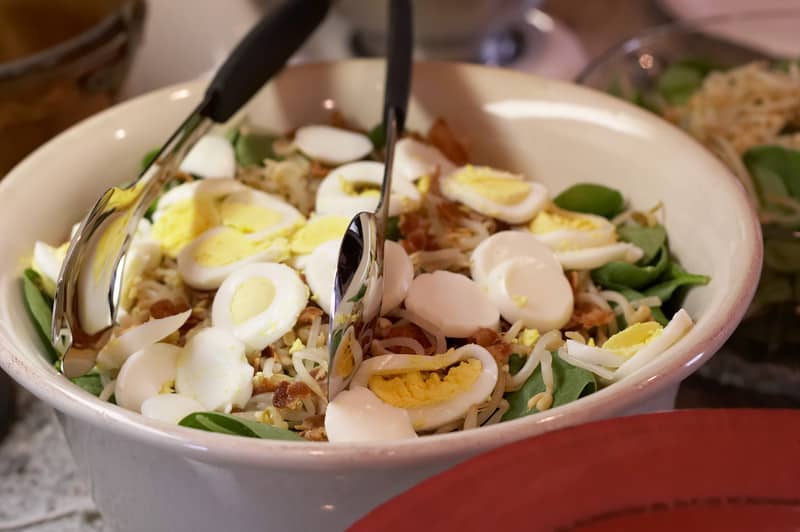
Spinach serving suggestions
- The dark green leaves of fresh spinach will add color to a lettuce salad.
- Spinach can be served raw in sandwiches and salads. Just add a little lemon juice.
- Add orange segments and almonds to a fresh spinach salad and toss in a sweet-sour dressing.
- Add cubes of cheese and sliced fresh peppers and mushrooms to a spinach lunch salad.
- The classic spinach salad includes bacon, mushrooms, hard-boiled egg quarters with warm mustard, and bacon fat dressing.
- A spinach salad can be topped with grilled Portobello mushrooms and strips of spice-marinated grilled chicken.
- It can be served with a basic béchamel sauce or a rich Mornay sauce.
Spinach cooking suggestions
- Spinach can be baked au gratin or puréed.
- Try spinach with a horseradish sauce or with melted butter and a little garlic.
- Serve spinach with spring vegetables such as baby carrots and young fava beans.
- Eggs, fish, poultry, and meats that are served on a bed of spinach, usually with a sauce, are often appended with the phrase à la Florentine. The term originated in 1533 when Caterina de Medici traveled from Florence to marry the king of France. She brought along her favorite Florentine cooks who used spinach in many royal dishes.
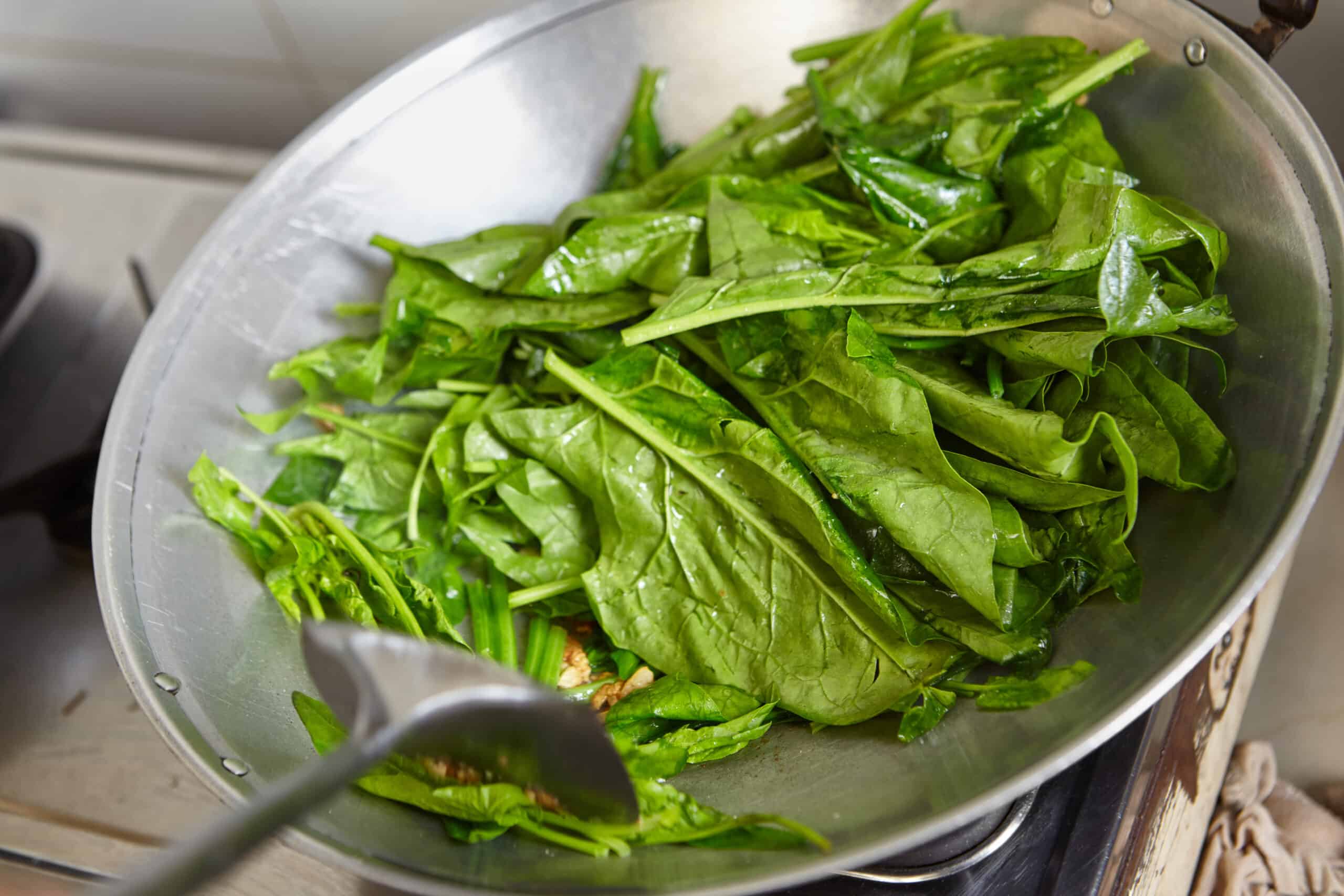
How to wilt spinach
- Cook spinach in a saucepan or a skillet with just the water that clings to the leaves after washing.
- Add a sprinkling of salt and place the pan over low heat.
- Cover the pan so that the spinach steams in its own liquid.
- Shake the pan occasionally to prevent the spinach from sticking to the bottom. Spinach will cook in 4 to 6 minutes wilting down to about an eighth of its volume.
- Drain and press out the remaining liquid.
- Chop and serve with lots of butter.
Wilted spinach can also be prepared with minced garlic sautéed garlic in olive oil or hardboiled eggs.
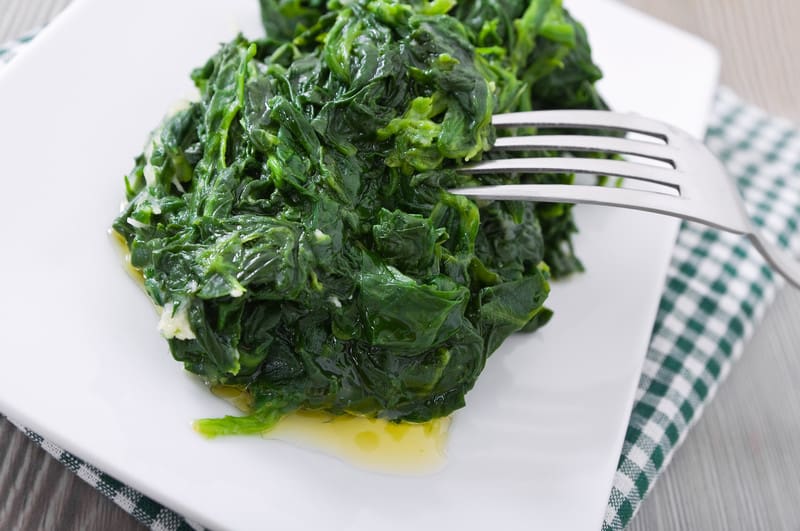
How to steam spinach
- Wash the spinach and arrange it so that all the stems are going in the same direction.
- Place a steam basket in a pot with an inch or two of water; the basket should not touch the water.
- Bring the water to a boil and set the spinach in the basket.
- Steam the spinach for 2 to 4 minutes.
- Arrange the spinach on a serving dish, spoon melted butter over the spinach, and serve with lemon wedges.
Spinach butter cooked in a saucepan
- Wash and clean the spinach.
- Crosscut the spinach into 2-inch lengths.
- Melt butter in a saucepan and layer in the spinach, sprinkle each layer with a bit of salt.
- Cover and cook over moderate heat; the spinach will wilt in 2 to 5 minutes.
- Spinach will cook in the water it’s cleaned with if it seems dry add a bit of water.
How to purée spinach
- Wilt the spinach as directed above.
- Drain or dry the spinach as much as possible.
- Purée in a food processor or chop it by hand, add 4 to 6 tablespoons of melted butter, 2 tablespoons of heavy cream, and a dash of nutmeg, then blend well.
How to make creamed spinach
- Bring a large pot of lightly salted water to a boil.
- Plunge washed and trimmed spinach into the boiling water and cook for about 1 minute.
- Remove the spinach with a slotted spoon and chill it in iced water to stop the cooking.
- Drain the spinach and chop it finely.
- Put a cup of light or heavy cream and 2 tablespoons of butter in a large saucepan over medium heat.
- Cook stirring occasionally until the spinach has absorbed a lot of the cream and thickened about 10 minutes.
- Add a bit of nutmeg and pepper to taste and serve hot.

How to make spinach soup
- Wash and clean the spinach and cut off large stems.
- Sauté diced onion for several minutes in olive oil and butter until it softens.
- Add minced garlic and cook for 1 more minute.
- Add 4 tablespoons of flour and cook for 3 or 4 more minutes
- Remove the pan from the heat and whisk in 2 cups of heated vegetable stock or water.
- Return to the heat and add the spinach, a bit of chopped parsley, and salt and pepper to taste.
- Cook until the spinach wilt; cover and simmer for 10 minutes.
- Puree with an immersion blender or in a blender.
- Add milk or water to the desired thickness.
- Heat and adjust the seasoning.
- Serve garnished with sour cream or yogurt.
Four more ways to prepare spinach
Here are four more delicious ways to prepare and serve fresh spinach from your home garden:
1. Sautéed Garlic Spinach
- Preparation: Heat a bit of olive oil in a large skillet over medium heat, then add a few minced garlic cloves. Sauté the garlic until fragrant (about 30 seconds to 1 minute), then toss in fresh spinach leaves. Cook until wilted, stirring occasionally, for about 3-5 minutes. Season with salt, pepper, and a squeeze of lemon juice for brightness.
- Serving: Serve as a side dish with grilled chicken, fish, or pasta. You can also top it with some toasted nuts for extra texture and flavor.
2. Spinach and Feta Stuffed Chicken Breasts
- Preparation: Butterfly chicken breasts and stuff them with a mixture of sautéed spinach, garlic, crumbled feta cheese, and a touch of lemon zest. Secure with toothpicks, then sear the chicken in a hot pan until golden on both sides. Transfer to an oven preheated to 375°F (190°C) and bake for 15-20 minutes, or until the chicken is fully cooked.
- Serving: Serve this stuffed chicken with a side of roasted vegetables or a simple salad.
3. Creamed Spinach
- Preparation: Blanch fresh spinach leaves in boiling water for 1-2 minutes, then drain and squeeze out excess water. In a separate pan, melt butter and sauté a little minced garlic. Stir in some cream, a pinch of nutmeg, and salt. Once the mixture is warm, add the blanched spinach and cook for 3-5 minutes until thickened. For extra richness, you can add a bit of grated Parmesan cheese.
- Serving: Creamed spinach pairs wonderfully with steak or roasted meats and is also a classic holiday side dish.
4. Spinach and Mushroom Quiche
- Preparation: Make a flaky pie crust or use a store-bought one. In a pan, sauté fresh spinach with mushrooms, garlic, and onions until soft. Spread the mixture evenly in the pie crust. In a bowl, whisk together eggs, cream, salt, pepper, and a little grated cheese (such as Gruyère or cheddar). Pour the egg mixture over the spinach and mushrooms, then bake in a preheated oven at 350°F (175°C) for 35-40 minutes, until the quiche is set and lightly golden.
- Serving: Serve warm or at room temperature, great for brunch, lunch, or dinner.
These recipes highlight spinach’s versatility, from simple and light to creamy and savory dishes. Each brings out the fresh, vibrant flavor of garden-grown spinach.
A few more ways to prepare spinach
Here are four delicious ways to prepare and serve fresh spinach from your home garden:
For a quick and flavorful side dish, sauté fresh spinach with garlic. Start by heating olive oil in a skillet, then add minced garlic and cook until it becomes fragrant. Toss in the spinach leaves and stir occasionally until they wilt, which only takes about 3-5 minutes. Finish with a sprinkle of salt, pepper, and a squeeze of lemon juice to brighten the flavors. This simple dish pairs well with grilled meats or can be served as a healthy topping for pasta or rice.
Next, take your weeknight dinner up a notch by stuffing chicken breasts with sautéed spinach and crumbled feta. Butterfly the chicken breasts and fill them with a mixture of cooked spinach, garlic, and feta cheese, then secure the chicken with toothpicks. Sear the stuffed chicken in a pan until golden brown, then finish it in the oven until fully cooked. The result is a flavorful, juicy chicken with a delicious cheesy-spinach filling that’s perfect alongside roasted vegetables or a simple salad.
Creamed spinach is a rich and indulgent dish that’s perfect as a side for roasted meats or as part of a holiday spread. To prepare, briefly blanch the spinach, then sauté garlic in butter. Add cream and a pinch of nutmeg, then stir in the spinach and let it simmer until thick and creamy. For an extra layer of flavor, add a bit of grated Parmesan cheese. This dish has a velvety texture and a savory richness that complements any meal.
Next, a spinach and mushroom quiche makes for a delicious and satisfying meal at any time of day. Sauté fresh spinach with mushrooms, garlic, and onions, then spread the mixture into a prepared pie crust. Whisk together eggs, cream, salt, pepper, and a bit of cheese, then pour it over the spinach. Bake the quiche until it’s set and golden brown. Serve it warm or at room temperature, making it a versatile dish for brunch, lunch, or dinner.
These recipes highlight spinach’s versatility, from simple and light to creamy and savory dishes. Each brings out the fresh, vibrant flavor of garden-grown spinach.
Spinach flavor partners
- Spinach is a good match for veal, poultry, fish, aged cheese, cream cheese, eggs, egg noodles, garlic, mushrooms, nutmeg, onions, shallots or sour cream.
Spinach nutrition
- Spinach is a rich source of vitamins A and C and B, but it contains oxalic acid which inhibits the body’s absorption of calcium and iron.
- One cup of fresh spinach contains about 10 calories.
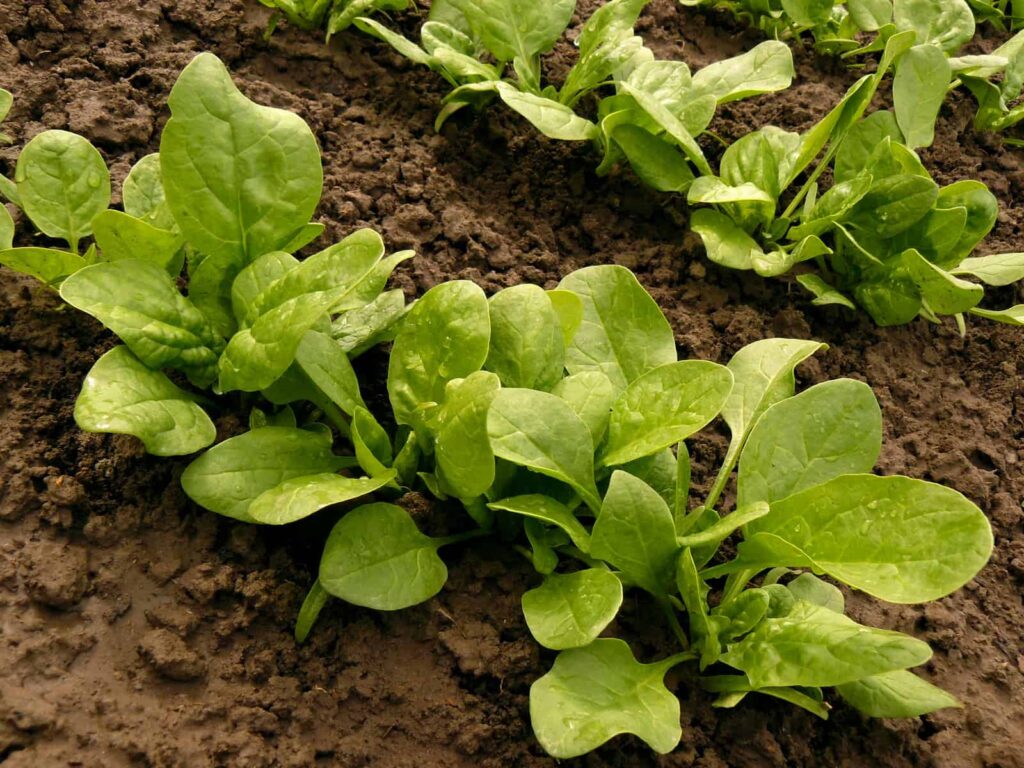
Get to know spinach
- Spinach grows as a rosette of dark green leaves to about 4 to 6 inches (10-15 cm) tall and about 6 to 8 inches (15-20 cm) across. Smooth leaf varieties have thin, tender, sweetly flavored leaves. Crinkle or savoy-leaved spinaches have broader, thicker leaves that hold up better when cooked.
- Spinach originated in the Iranian desert near Dasht-e-Kavir and was transplanted to Persian gardens in about the fourth century. The name spinach derives from an old Persian name aspanākh—isfanakh—which means “a green hand”.
- Spinach was brought to Spain by the Arab conquerors as early as the eighth century and from there spread to the rest of Europe. The Arabic name for spinach was esbanash; in Spanish the name became espinaca. The first English cookbook reference to spinnedge came in the fourteenth century and referred to it as the Spanish vegetable.
- Popeye the Sailor Man made his first appearance in American comics in January 1929, the creation of E.C. Segar. Popeye’s strength was derived from spinach. He often quipped, “I’m strong to the finish ‘cause I eats my spinach.” American consumption of spinach grew by 33 percent in the years immediately following the first appearance of Popeye.
The botanical name for spinach is Spinacia oleracea.
Spinach articles on Harvest to Table:
- How to Plant and Grow Spinach
- Spinach Seed Starting Tips
- How to Harvest and Store Spinach
- Spinach Growing Problems: Troubleshooting
- Six Ways to Cook and Serve Spinach
- How to Grow New Zealand Spinach
- How to Grow Malabar Spinach
Articles of interest:
Best Herbs for Container Growing
Garden Planning Books at Amazon:
- Vegetable Garden Almanac & Planner
- Kitchen Garden Grower’s Guide Vegetable Encyclopedia
- Vegetable Garden Grower’s Guide
- Tomato Grower’s Answer Book
More kitchen tips:
Bring your harvest to the table. Kitchen prep tips and easy recipes for the vegetables you grow. Click below for vegetable prep and recipes you can use now.
- Almonds
- Apples
- Apricot
- Aprium
- Artichoke
- Arugula
- Asparagus
- Avocado
- Bamboo Shoots
- Banana
- Basil
- Beans, Dried
- Beans. Long
- Beans, Shell
- Beans, Snap
- Beets
- Bitter Melon
- Blackberry
- Bok Choy
- Broccoli
- Broccoli Raab
- Brussels Sprouts
- Cabbage
- Cardoon
- Carrots
- Cauliflower
- Celeriac
- Celery
- Chard
- Chayote Squash
- Cherimoya
- Cherries
- Chestnut
- Chickpea
- Chinese Cabbage
- Chives
- Cilantro
- Citron
- Clementine
- Collards
- Coriander
- Corn, Sweet
- Corn, Baby
- Corn Salad, Mache
- Cranberry
- Cress
- Cucumber
- Daikon
- Dandelion
- Dill
- Eggplant
- Endive, Belgian
- Endive and Escarole
- Fava Beans
- Fig
- Florence Fennel
- Garlic
- Ginger
- Grapefruit
- Grapes
- Guava
- Horseradish
- Jerusalem Artichoke
- Jicama
- Jujube
- Kale
- Kiwifruit
- Kohlrabi
- Kumquat
- Leeks
- Lemongrass
- Lemons
- Lettuce
- Lime
- Mache (Corn Salad)
- Mandarin Orange
- Mango
- Maple Syrup
- Marjoram
- Melons
- Michihili
- Mint
- Mizuna
- Mushrooms
- Mushrooms, Cremini
- Mustard Greens
- Napa Cabbage
- Nectarine
- Okra
- Olives
- Olive oil
- Onions
- Oranges
- Oregano
- Parsley
- Parsley Root
- Parsnips
- Passion Fruit
- Pawpaw
- Peaches
- Pears
- Peas, Garden Snap
- Peas, Snow
- Pei Tsai
- Peppers, Chili
- Peppers, Sweet
- Persimmon
- Pineapple
- Pineapple Guava
- Plantain
- Plums
- Pluots
- Pomegranate
- Potatoes
- Prickly Pear
- Pumpkin
- Quince
- Radicchio
- Radishes
- Raspberries
- Rosemary
- Rhubarb
- Rutabaga
- Sage
- Salsify
- Sauerkraut
- Savory
- Shallots
- Sorrel
- Spinach
- Squash, Summer
- Squash, Winter
- Strawberries
- Sunchokes
- Sunflower
- Sweet Potato
- Swiss Chard
- Tangerine
- Taro
- Tarragon
- Thyme
- Tomatillo
- Tomato
- Turnip
- Turnip Greens
- Yams


